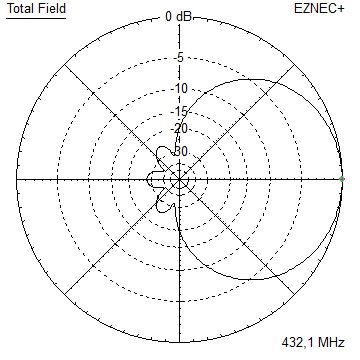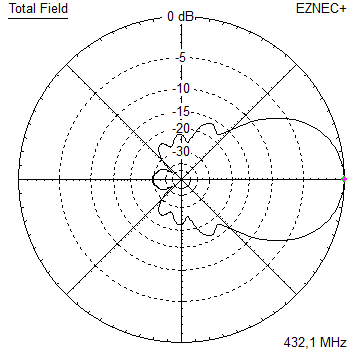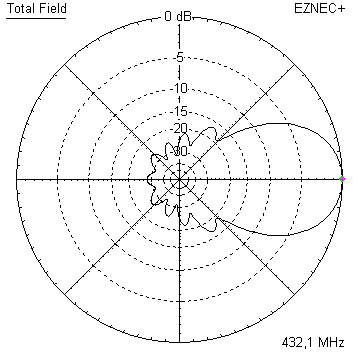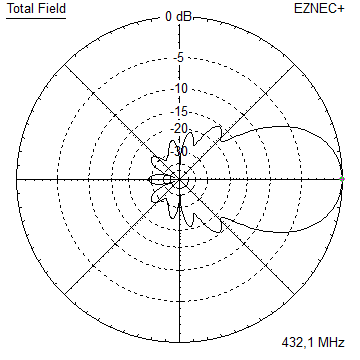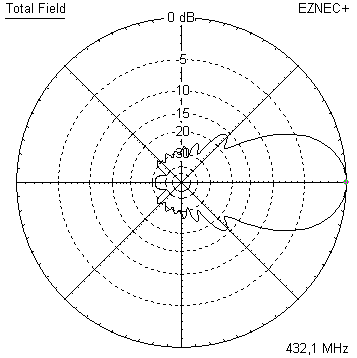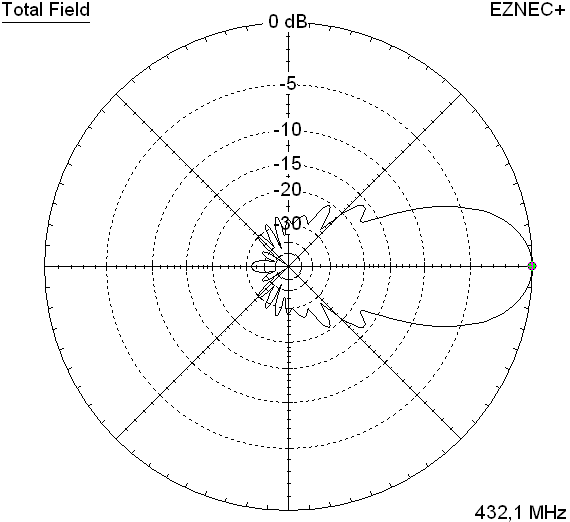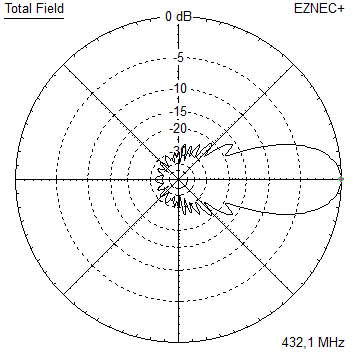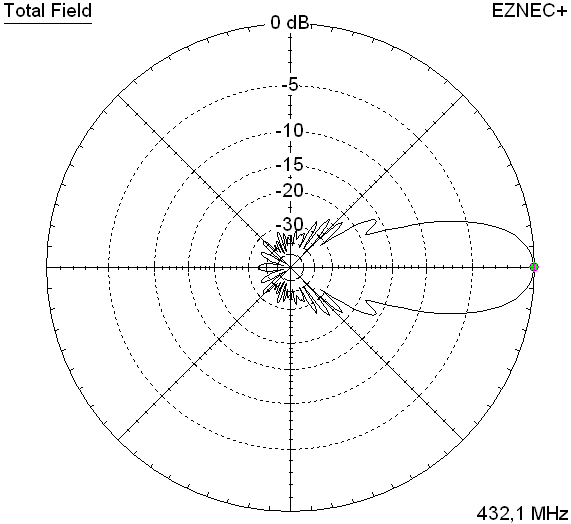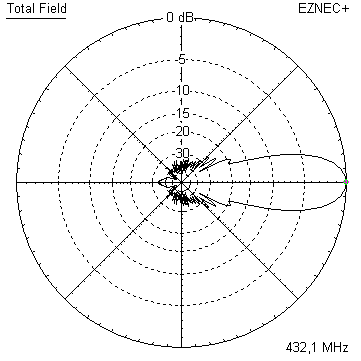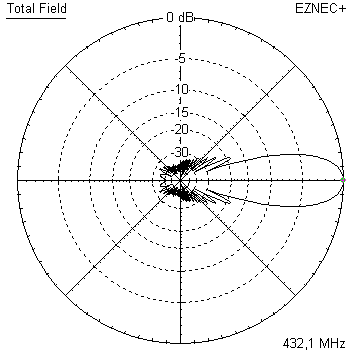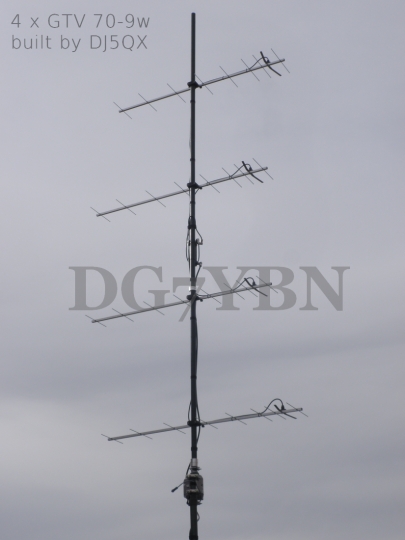
GTV 70-9w Yagi with bent Driven Element
EME + SSB band to FM up to 436 MHz. With marginal degradation it can be used even in the
satellite band section (max. VSWR 440 MHz ~ 1.5). Its VSWR is flat well below 1.1 from 430 to 436 MHz.
This Yagi has very low back lobes for its length. It may serve as single antenna for portable
use and certainly make a useful 4 x vertical stack. It makes a quiet contest antenna due to its
high F/B. The bent DE (K6STI style) transforms from approx. 17 ohms to 50 ohms at feed point.
GTV 70-9w in a very portable version by Torsten, DG7RO

4 x 4 x GTV 70-9w by DL1KRK & DL5KBG at DL0GM
Michael, DL5KBG: "Hallo Hartmut,
wir haben auf 70cm nach den guten Erfahrungen letztes Jahr ganz auf die 9 El. Yagi umgeschwenkt."
"After the good experience last year we moved to the 9 el. Yagi completly."

Photo Credit: DL5KBG. Tnx Michael!
6 x vert. GTV 70-9w by DK1RS


Photo: on courtesy of DK1RS, tnx Rainer!
4 x GTV 70-9w by M0ABA at MX0CNS



Another first ...
 Backpacker battery driven moonbounce with a GTV 70-9w by Dennis, W5RZ
Backpacker battery driven moonbounce with a GTV 70-9w by Dennis, W5RZ


This Yagi is built on a wooden lace, TRX used was an FT 817 and 40 W PA on batteries.
The QSO took place 2019.02.16, other station was DL7APV.
This is the lowest EIRP backpack EME QSO with smallest Yagi we have seen so far.
W5RZ does those things to show you how easy it can be to get QRV on EME.
Have a go, you do not need special equipment to work a few big guns!
4 x vertical 'stagger stack' of GTV 70-9w built by Mathias, DJ5QX: Click on images to enlarge
GTV 70-9w built by Mathias, DJ5QX

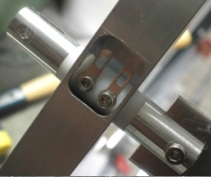
dismissed by applying port extension: Return Loss, S11 and Z = R + jX as Smith Chart.
We find 2 chartlines for antenna beaming at different angles for judging the influence of the home 'test range'.


4 x vertical stack of GTV 70-9w at DL0GM built by Michael, DL5KBG and Ralf, DL1KRK:

And Sheet Metal Dipole the other way round:
GTV 70-9w built by Kazuo, 7L1TIG, see his website for details and VSWR plot
Photo: with kind permission of Kazuo, 7L1TIG

GTV 70-9w built by Thomas, M0ABA

GTV 70-9w built into a YBN 2-5m by Ed, K9EK

Current distribution


Performance Data
Specs: with 4 mm elements @ 432.1 MHz
Gain vs. isotr. Rad. 13.5 dBi Gain vs. Dipole 11.4 dBD -3 dB E-plane 40.4 deg. -3 dB H-plane 45.8 deg. F/B -30.0 dB F/R -25.5 dB Impedance 50 ohms Mechan. Length 1438 mm incl. 2 x 30 mm stand off Electr. Length 1.99 λ Stacking dist. h-pol. top-to-bottom 0.89 m or 2.92 ft side-by-side 1.00 m or 3.29 ft
How many OMs have been looking up this design?
Geometry
This Yagi with 8 mm elements on a 15 x 15 mm boom with standard insulators

|
Ele. 8.0 mm DE 10 mm Boom 15 x 15 mm |
|

This Yagi with 8 mm elements on a 20 x 20 mm boom with standard insulators

|
Ele. 8.0 mm DE 10 mm Boom 20 x 20 mm |
|

Bent Dipole: DE(a) is the inner straight length and pos. on boom, DE(b) is position of tips and span width when bent

| • Drawing of the blade dipole of the M0ABA built GTV 70-9w as PDF (tnx Thomas, M0ABA for measuring this!) |

|
• Drawing of the blade dipole of the DK1RS built GTV 70-9w as PDF (tnx Rainer for measuring and drawing this!) If of help this drawing is available as .dxf on request. |

Symmetry line is center of boom, reflector and distance dipole tips to reflector are included.
Boom is 15.9 x 15.9 mm. These builds were subject to extensive testing with a VNA.
 <= NEC Geometry for 4 mm ele. insulated through boom excluding BC
<= NEC Geometry for 4 mm ele. insulated through boom excluding BC
Ø4 mm Elements - Through Boom - Dimensions (BC acc. SM5BSZ's BC.exe)
EZNEC wire table for Ø 4 mm elements

The model uses EZNEC's Auto-Segmentation at 1050 MHz.
The DE's is 10 mm for all examples.
Using a 'Blade Dipole' is recommended with elements through boom
A simple symmetrising section may be made from a 3 x 1/4 Lambda line grounded at the far end with
N-flange-bushing and an aluminium plate and ferrite core added as close as possible to the DE,
see below.
Table 1: GTV 70-9w, 4 mm elements through boom:
"Ready to saw and drill" data for mounting elements through boom with BC according SM5BSZ's BC.exe:
Note: with through Boom BC it is important to stick to the boom end offsets given below!
|
This table is only valid for: Boom shape: square Boom dim: 20 x 20 mm Wall thickn.: 2.0 mm Holes in boom: 6.0 mm Offset rear: 30 mm Offset front: 30 mm |
|
Note: This does include a "Segmentation Density Correction" (SBC) of 1.46 mm.
Which does not include any correction for the insulators, which is around 0.7 mm depending on
the very insulator properties and is still to be added to the length of each element as fix offset.
Read abt. the SBC here
Note: with through Boom BC it is important to stick to the boom end offsets given below!

Table 2: GTV 70-9w, 4 mm elements through boom,
formast mount with 380 mm offset on rear boom end:
"Ready to saw and drill" data for mounting elements through boom with BC according SM5BSZ's BC.exe:
|
This table is only valid for: Boom shape: square Boom dim: 20 x 20 mm Wall thickn.: 2.0 mm Holes in boom: 6.0 mm Offset rear: 380 mm Offset front: 30 mm |
|
Note: This does include an SBC of 1.46 mm plus a correction for the insulators (v-factor!) of 0.7 mm
for compensation of the insulators (7arrays.com
Note: with through Boom BC it is important to stick to the boom end offsets given below!

Using a large calliper gauge to control lenghts to the 10th of a millimeter is a must.
Table 3: GTV 70-9w, 4 mm elements through a 5/8 inch boom,
formast mount with 380 mm offset on rear boom end:
"Ready to saw and drill" data for mounting elements through boom with BC according SM5BSZ's BC.exe:
|
This table is only valid for: Boom shape: square Boom dim: 5/8 x 5/8 inch Wall thickn.: 1/16 inch = 1.6 mm Holes in boom: 6.0 mm Offset rear: 380 mm Offset front: 30 mm |
|
Note: This does include an SBC of 1.46 mm plus a correction for the insulators (v-factor!) of 0.7 mm
for compensation of the insulators (7arrays.com
Note: with through Boom BC it is important to stick to the boom end offsets given below!

Using a large calliper gauge to control lenghts to the 10th of a millimeter is a must.
The CVS file for the Yagi Element Configuration Tool for own variations:
You can find the CSV file containing the set of data for this design in the download section.
Import that into my Yagi Element Configuration Tool
Building hints:
For building hints see the GTV 70-19
For fastening elements through boom
For making of a 'Blade Dipole'
Radiation Pattern and VSWR Plots
Elevation and Azimuth plot at 432.1 MHz
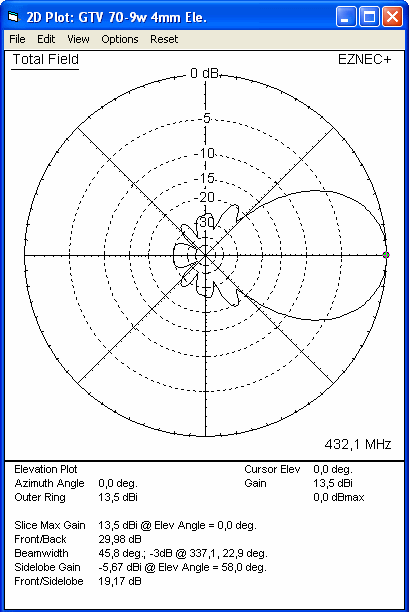

SWR and Return Loss plots - simulated with 4nec2

Return Loss and VSWR Plots by Thomas, M0ABA: -50 dB resp. 1:1.005 at 432.1 MHz


Gain, F/B and F/R 431 to 434 MHz

Radiation Pattern 430 to 440 MHz, Elevation Pattern




This yagi as an xpol





I have a file with 3/16 inch elements.
BC and geomerty table on request ...
Downloads
EZNEC file of this Yagi with Ø 4 mm ele.
EZNEC file of this Yagi with Ø 8 mm ele.
CSV file for the Yagi Element Configuration Tool with 4 mm elements
Stacking
As on 432 MHz the Y-factor = T_earth / T_sky is so high, I see little chances to
improve an array's RX performance by using "Over Stacking" distances. However, depending on
the level of local QRM it might be worthwhile to try a decreased distance, especially in the H-plane.
Stacking Dist. DL6WU Formula H-plane 1.00 m E-plane 0.89 m
A vertical 4 Yagi stack

Elevation plot and data of 4 Yagi bay using DL6WU stacking distances


Gain vs. isotr. Rad. 19.36 dBi Gain vs. Dipole 17.21 dBD -3 dB H-plane, appr. 40.8 deg. -3 dB E-plane, appr. 10.0 deg. F/B -29.4 dB F/R -28.8 dB T_ant 30.3 K* G/T 4.54 dB*Theoretical numbers - these do not include phasing line losses
nor imperfections caused by H-frames or mast poles etc.
*) T_sky = 20 K, T_earth = 350 K as in VE7BQH G/T table
Screenshot of TANT for this 4 Yagi stack

A vertical 6 Yagi stack
21.1 dBi at a HPBW of 40 degr. on less than 4.5 m of height on pole
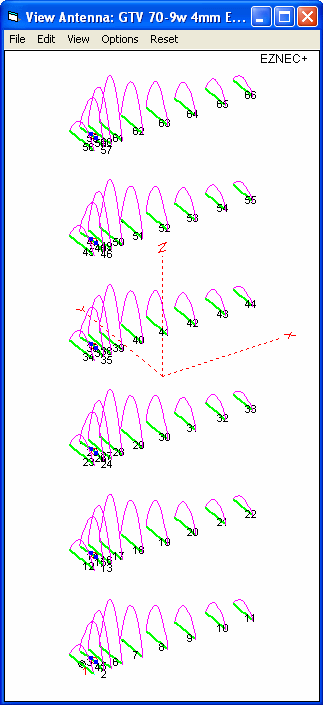

Stagger Stacked 4 x GTV 70-9w
Stacking distance is acc. DL6WU = 890 mm + 70 mm = 960 mm each
Gain vs. isotr. Rad. 19.51 dBi Gain vs. Dipole 17.36 dBD F/B -47.4 dB F/R -32.1 dB
Inner Yagis are displaced in forward direction by 169 mm and fed at -90 degr

Free Space Elevation Pattern

Simulated at 3.0 m over perfect ground - 4nec2's 3D viewer - structure and pattern

Simulated at 3.0 m over perfect ground - Azimuth Pattern

View the effect of Stagger Stacking on a 4 x vert. bay of 4 GTV 70-9w simulated with CST EM Software (tnx Mathias, DJ5QX!)
• Conventional Stack at DL6WU distances.
These are non-normalised cartesian plots: At 20 dB of forward gain a -10 dB (mark 1, 2) on rear lobe means -30 dB of F/B.

• Stagger stacked as described above

Read more about Stagger stacking here
and here
Symmetrising 50 to 50 ohms feedline to 432 MHz Bent DE
The principle is similar to the 1/4 Lambda coax. Adding 2 x 1/4 Lambda or a half wave line does not change anything but allows
to form a gentle bow below the boom or until behind the Reflector. Follow practical construction hints on "Building a Yagi" page.


 Attenzione!
Take care when lengthening the coax, measure the actual electrical length instead of considering v-factors specified in a catalogue only.
Attenzione!
Take care when lengthening the coax, measure the actual electrical length instead of considering v-factors specified in a catalogue only.A good choice may be the diam. 5 mm PTFE coax RG-142 B/U: real resonate length (432.2 MHz as 3/4 Lambda) shield-shield is around 348 mm
 Find more information on Phasing & Matching Lines page
Find more information on Phasing & Matching Lines page 73, Hartmut, DG7YBN






